Aurora / Shasta (Astro Digital Demo 9)
EO
Operational (nominal)
Orbital Sidekick Inc.
Astro Digital
Aurora is a hyperspectral imaging (HSI) technology demonstrator satellite developed by US startup company Orbital Sidekick and Astro Digital, launched in June 2021. The satellite is a precursor to Orbital Sidekick’s GHOSt (Global Hyperspectral Observation Satellite) constellation of six satellites, which has its first launch in April 2023.
Quick facts
Overview
| Mission type | EO |
| Agency | Orbital Sidekick Inc., Astro Digital |
| Mission status | Operational (nominal) |
| Launch date | 30 Jun 2021 |
| CEOS EO Handbook | See Aurora / Shasta (Astro Digital Demo 9) summary |
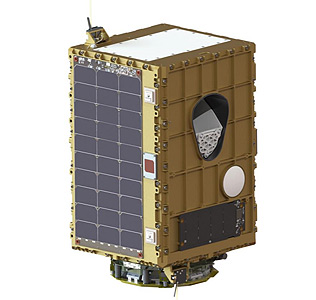
Summary
Mission Capabilities
Aurora features a high resolution hyperspectral imager which will measure greenhouse gas (GHG) emission, such as carbon dioxide (CO2), methane (CH4) and nitrous oxide (N2O). Orbital Sidekick will provide real-time insights for its customers into their GHG emission from sources including pipe leaks, and allow them to act fast. The hyperspectral imager provides Aurora with applications in energy, mining and defence sectors, oil and gas pipeline monitoring, methane mapping, clean-energy resource exploration, sustainable mining practices and wildfire risk mitigation.
Orbital Sidekick also offers customers their proprietary platform, SIGMA (Spectral Intelligence Global Monitoring Application), a software for users to access satellite imagery and insights from their chosen sites.
Performance Specifications
Aurora’s hyperspectral imager captures 450 continuous spectral bands from the visible and short-wave infrared (SWIR) spectrum at a spatial resolution of 30 m. Meanwhile, the improved imager onboard the GHOSt satellites features 512 spectral bands from the visible to SWIR spectrum, ranging from 400 - 2500 nm wavelengths at spectral resolution of 8 m for hyperspectral imaging and 3 m for panchromatic imaging.
Aurora imagery is processed and analysed in real-time using NVIDIA’s Jetson edge AI platform, and displayed through Orbital Sidekick’s SIGMA.
Aurora was launched into a 550 km altitude low Earth orbit (LEO) on 30 June 2021 onboard the SpaceX Falcon 9 Transporter-2 Rideshare mission from the U.S. Air Force Eastern test range. Aurora was deployed by Sherpa-LTE 1 into orbit with an orbital period of 94.8 minutes and inclination of 97.6°.
Space and Hardware Components
Aurora is based on the Astro Digital Corvus-Micro satellite bus, which has approximate mass and dimensions of 22.5 kg and 34 cm x 34 cm x 49 cm, respectively. The satellite achieves three-axis stabilisation without propellant through the use of reaction wheels, magnetorquers, star trackers, a magnetometer, sun sensors and gyroscopes. The satellite is constructed of six aluminium iso-grid panels, features body-mounted solar panels and has a design life of five years.
Aurora achieves full hemispherical coverage for communications with two UHF (Ultra High frequency) and two S-band TT&C (Tracking, Telemetry and Command) antennas, and is powered by eight standard Lithium-Ion batteries. The satellite has four operating modes, Sun pointing safe mode, target tracking mode, nadir tracking mode, and Sun clocking mode.
Aurora / Shasta (Astro Digital Demo 9)
Overview
US startup company Orbital Sidekick (OSK) has developed a hyperspectral imaging constellation, consisting of six satellites. The San Francisco based-company launched a technology demonstration precursor satellite called Aurora in June 2021, and the first two satellites of the GHOSt (Global Hyperspectral Observational Satellite) constellation in April 2023. OSK plans to deploy six GHOSt microsatellites into orbit by the end of 2023, launching four satellites onboard SpaceX’s Transporter-8 and -9 Rideshare missions. OSK is the only commercial hyperspectral imaging (HSI) provider with proprietary satellites and detection tools designed to optimise sustainable operations in real time, and became the first US commercial company to deploy hyperspectral sensors in space.
Aurora, also known as Shasta or Astro Digital Demo 9, shares the same Earth observation applications as GHOSt. These include applications in energy, mining and defence sectors, oil and gas pipeline monitoring, methane mapping, clean-energy resource exploration, sustainable mining practices and wildfire risk mitigation. The satellite will measure greenhouse gases (GHGs) including carbon dioxide, methane and nitrous oxide at point-source level. Aurora will help provide consistent monitoring services to all their clients as well as further the exploration for globally clean energy sources. The six-satellite constellation will provide as frequent as daily revisits for certain locations. The GHOSt constellation will build on the Aurora mission with observations over more spectral bands and at a higher spatial resolution (8 m). 1) 2)
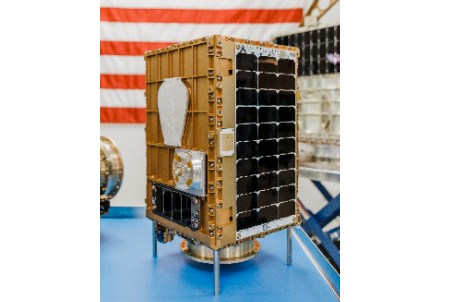
OSK sent its first technology demonstration to space in 2018, which was a breadboard-sized hyperspectral imager that spent a year and a half attached to the International Space Station. The demo was followed by Aurora in 2021. OSK has also conducted airborne programs, where their hyperspectral imagers were used onboard aircraft, but satellites have proven to be the most effective and scalable solution. The startup company plans to expand the GHOSt constellation to at least 14 satellites, to provide a “hyperspectral atlas of the world”. 3)
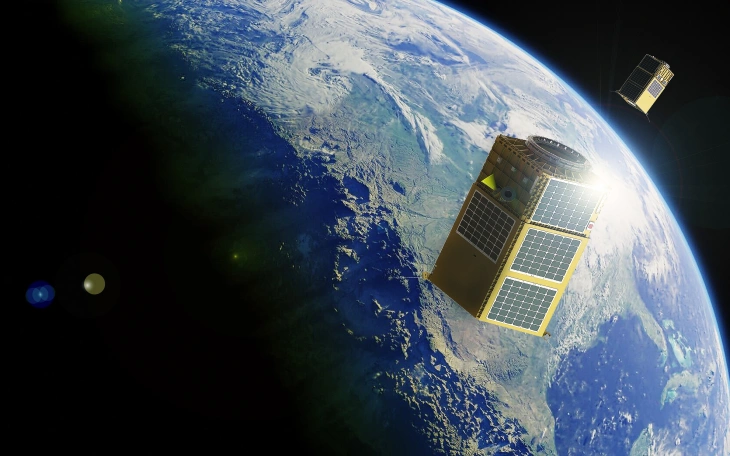
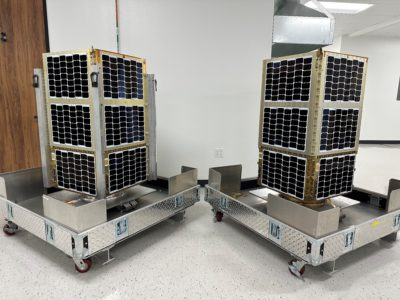
Spacecraft
Aurora is based on the Astro Digital Corvus-Micro satellite bus, which makes use of reaction wheels, magnetic torque coils/rods, star trackers, magnetometer, sun sensors, and gyroscopes to enable 3-axis pointing without the use of propellant. The satellite has a mass of approximately 22.5 kg, and approximate dimensions of 34 cm x 34 cm x 49 cm. The satellite is constructed of six aluminium iso-grid panels and features body-mounted solar panels. 4)
Aurora has a minimum design life of five years, and is expected to passively deorbit within 14.1 years after launch.

Two independent UHF (Ultra High Frequency) TT&C (Tracking, Telemetry and Command) antennas protrude from opposite sides of the spacecraft, as well as two S-band TT&C antennas located on the top and bottom faces, together providing full hemispherical coverage. The satellite is powered by eight unpressurised standard COTS (Commercial Off The Shelf) Lithium-Ion batteries run in parallel. Aurora has four operating modes, which include:
- Sun pointing safe mode, optimised for solar power generation by the satellites body mounted solar panels oriented towards the Sun with the star tracker pointed anti-nadir.
- Target tracking mode, allowing the spacecraft to track the ground station.
- Nadir tracking mode, used for payload operation.
- Sun clocking mode, a complementary mode to the others where the spacecraft orientates itself for maximum power generation. 4)
Launch
Aurora was launched from the US Air Force Eastern test range (AFETR) on 30 June 2021 on a SpaceX Falcon 9 launcher. The satellite was launched by the Transporter-2 Rideshare mission into an orbit with perigee of 503 km, apogee of 524 km, inclination of 97° and period of 94.8 minutes. The payload was deployed by the Sherpa-LTE 1 free flying satellite deployer onboard the Falcon 9. 5)
Secondary Payloads
The secondary payloads in the SpaceX Rideshare flight with Aurora included:
- Three prototype SpaceX Starlink v1.5 satellites
- Umbra-SAR 2001, a Synthetic Aperture Radar (SAR) satellite developed by Umbra Lab of California as the first satellite in the Umbra-SAR constellation. The mission is a technology demonstrator, using a proprietary antenna technology to obtain high quality SAR imagery.
- ÑuSat 19 - 22, the Argentinian Earth observation satellites from the Aleph-1 / ÑuSat constellation developed by Satellogic with the objective of producing daily global remaps.
- ICEYE X11, X12, X13, X15, four SAR microsatellites of the constellation developed by Finnish ICEYE startup company.
- Capella 5, a SAR satellite in the Capella constellation by Capella Space of California.
- GNOMES 2 (GNSS Navigation and Occultation Measurement Satellites) 2, a small satellite in the GNOMES constellation of PlanetiQ to provide radio occultation data for weather forecasting, climate research, and space weather monitoring.
- TROPICS 01 (Time-Resolved Observations of Precipitation structure and storm Intensity with a Constellation of Smallsats), the technology demonstrator pathfinder mission of the MIT TROPICS constellation.
- Sherpa-FX 2, a free-flying satellite deployer by Spaceflight Inc., which carried:
- Lynk 06, an experimental communications satellite by Lynk Global to test mobile phone communications.
- Hawk 3A - 3C, two small satellites in the Hawk constellation of HawkEye 360, a space-based civil global intelligence network.
- Astrocast 0201 - 0205, nanosatellites from Astrocast SA’s constellation for global machine-to-machine services.
- Lemur-2 140 - 144, five satellites in the Lemur-2 constellation by Spire.
- Painani 1, a 3U Cubesat of the Mexican Defence Agency. 6)
Mission Status
- January 31, 2023: Orbital Sidekick announces a $10 million investment led by Energy Innovation Capital, with support from North American energy companies Williams and ONEOK. The funding will aid OSK in developing and launching their six-satellite GHOSt constellation, which they plan to have in orbit by this winter. 3)
- October 6, 2022: Orbital Sidekick selected by the intelligent pipeline integrity program (iPIPE) to serve as the company’s technology partner. iPIPE is a consortium dedicated to the advancement of emerging technologies for the prevention and detection of pipeline leaks. EERC Assistant Director for Energy, Oil and Gas, Darren Schmidt states: “We are excited to be partnered with OSK to have next-level technology in space that provides continuous monitoring of pipeline assets, this technology has the potential to give new capability for operators to prevent incidents and respond quickly to potential issues." 8)
- February 17, 2022: Aurora’s first light imagery is validated, using a comparative study between Aurora and two well-known sensors in orbit: Hyperion and PRISMA, found onboard the respective EO-1 and PRISMA satellites. The observed signal to noise ratio of Aurora was several times better than Hyperion, and made SWIR (Short-wave Infrared) measurements consistent with PRISMA. 9)
- April 13, 2021: Orbital Sidekick secures a $16 million series A funding round led by Temasek, an investment company located in Singapore, in order to expand OSK’s product offerings, new strategic partnerships, and introduce its advanced monitoring technology to new industries. The funding round also included contribution from Energy Innovation Capital and existing investors including Allied Minds and 11.2 capital, and Syndicate 708.
- COO and Co-Founder of OSK, Tushar Prabhakar states: “Paired with our recent $16M United States Air Force contract award in October 2020, the close of this Series A round allows us to focus on the deployment of the GHOSt constellation and the commercial release of our monitoring services platform SIGMA™.” OSK aims to become a global leader providing targeted solutions for customer pain points, in response to the energy sector’s demands for better leak prevention and monitoring. 10)
Sensor Complement (Hyperspectral Imager)
Hyperspectral imaging (HSI) allows for frequent data collection to build detailed analyses and insight into the target location. Standard optical imagery features only a few colour bands and cannot characterise material or molecular composition. Aurora’s hyperspectral imager captures 450 narrow continuous spectral bands in the visible and shortwave infrared spectrum at a 30 m spatial resolution, and is capable of measuring carbon dioxide (CO2), methane (CH4), nitrous oxide (N2O) and other greenhouse gases. 1)
The GHOSt satellites will image in 512 spectral bands across the visible to SWIR region, ranging from 400 - 2500 nm in wavelength at 8 m HSI and 3 m panchromatic spatial resolutions. 7)
Hyperspectral imagery from the satellites is processed and analysed in real-time using the NVIDIA Jetson edge AI platform, and insights can then be viewed through OSK’s SIGMATM (Spectral Intelligence Global Monitoring Application). OSK’s imagery has monitored more than 20,000 km of pipelines for customers, and detected nearly 100 methane leaks, 200 hydrocarbon leaks, and more than 300 intrusive events related to digging or construction activities. OSK revealed these leaks have helped eliminate the potential for them to become serious energy crises. 11)
Aurora and GHOSt use the NVIDIA Jetson AGX Xavier module as an AI engine onboard the satellites to process the hyperspectral data collected. With approximately 15 orbits per day, NVIDIA can process all the onboard data from the satellites in an orbit within that same orbit, enabling continuous data capture. 11)
Ground Segment
Spectral Intelligence Global Monitoring Application (SIGMATM)
SIGMA™ Monitor is an integrated, customizable platform that provides real-time reporting for global persistent monitoring. Through SIGMA Monitor, OSK’s customers are able to track their site activity as often as daily, with revisit options to suit tailored requirements. It will also provide chemical IDs and classification down to the molecule with Spectral IntelligenceTM, and real-time reporting with insights and notifications enabling rapid response.
The process for this starts with data capture from the satellite constellation, which is securely transmitted to the cloud. Second, the gathered hyperspectral data is analysed and compared to current datasets to examine dynamic environmental activity and chemical changes. Lastly, the SIGMA™ Monitor provides real-time reporting and critical intel to the user so they can enact a rapid response. 12)
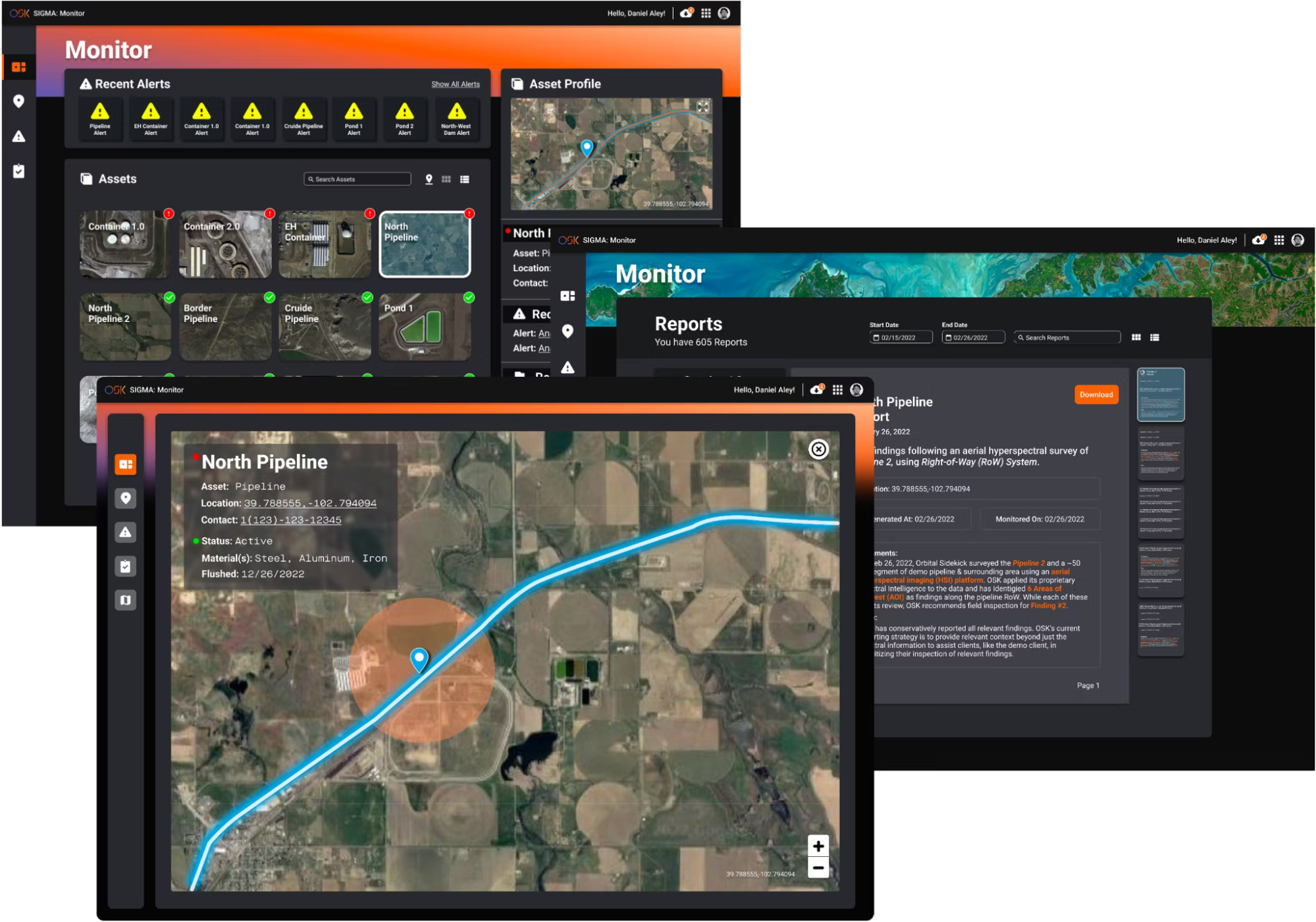
References
1) GEO, ClimateTRACE, WGIC, “GHG Monitoring from Space: A mapping of capabilities across public, private, and hybrid satellite missions,” 2021
2) “Orbital Sidekick Successfully Launches First Satellites in GHOSt Constellation,” GlobeNewswire, April 17, 2023, URL: https://www.globenewswire.com/news-release/2023/04/17/2648093/0/en/Orbital-Sidekick-Successfully-Launches-First-Satellites-in-GHOSt-Constellation.html
3) Aria Alamalhodaei, “Orbital Sidekick raises $10M to bring hyperspectral imaging to oil and gas pipeline monitoring,” TechCrunch, January 31, 2021, URL: https://techcrunch.com/2023/01/31/orbital-sidekick-raises-10m-to-bring-hyperspectral-imaging-to-oil-and-gas-pipeline-monitoring/
4) “Astro Digital Orbital Debris Assessment Report (ODAR),” March 18, 2021, Astro Digital
5) “DEMO 9 (Aurora),” N2Y0.com, URL: http://www.n2yo.com/satellite/?s=48956
6) Krebs, Gunter D. “Aurora (Shasta, Astro Digital Demo 9)”. Gunter's Space Page. Retrieved March 22, 2023, from https://space.skyrocket.de/doc_sdat/aurora_osk.htm
7) “About the GHOStTM Constellation,” Orbital Sidekick, URL: https://web.archive.org/web/20250321010151/https://www.orbitalsidekick.com/technology
8) “Orbital Sidekick Selected as Partner for Intelligent Pipeline Integrity Program (iPIPE),” Orbital Sidekick, October 6, URL: [web source no longer available]
9) “Orbital Sidekick Characterizes Aurora, Secures Key Partnership to Enhance USG Support,” February 17, 2022, URL: https://www.orbitalsidekick.com/news-blog/orbital-sidekick-characterizes-aurora-secures-key
10) “Orbital Sidekick Secures $16 Million Series A to Commercialize Hyperspectral Satellite Monitoring Solutions for Energy and Defense Sectors,” April 13, 2021, URL: https://www.orbitalsidekick.com/news-blog/orbital-sidekick-secures-16-million-series-a
11) Angie Lee, “Braced From Space: Startup Keeps Watchful Eye on Gas Pipeline Leaks Across the Globe,” NVIDIA, January 25, 2023, URL: https://blogs.nvidia.com/blog/2023/01/25/orbital-sidekick/
12) Orbital Sidekick, URL: http://www.orbitalsidekick.com/